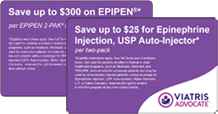
Epinephrine in schools
Approximately 1 in 13 children are affected by food allergies1— and children at risk for anaphylaxis may be present in almost every classroom.1,2 An estimated 13% to 23% of children with food allergies experience reactions at school.3
As a school nurse, you know that readily accessible epinephrine auto-injectors are integral to the emergency treatment of children with food allergies.4 Epinephrine is the only first-line therapy for anaphylaxis, according to the National Institute of Allergy and Infectious Diseases guidelines.5 But not all children at risk for anaphylaxis have received an epinephrine prescription or always carry their auto-injectors with them.6,7
That’s where the EPIPEN4SCHOOLS® program can help. EPIPEN4SCHOOLS is offered by Viatris Inc., the marketer and distributor of EPIPEN® (epinephrine injection, USP) and EPIPEN JR® (epinephrine injection, USP) Auto-Injectors, to help improve access to epinephrine in the school setting.
How EPIPEN4SCHOOLS works
The EPIPEN4SCHOOLS program provides up to four free EPIPEN (epinephrine injection, USP) or EPIPEN JR (epinephrine injection, USP) Auto-Injectors in the form of two EPIPEN 2-PAK® cartons, two EPIPEN JR 2-PAK® cartons or one 2-Pak of each kind along with EPIPEN Trainers and a detailed training video, to qualifying public and private kindergarten, elementary, middle and high schools in the US. Schools may receive the authorized generic versions of EPIPEN and EPIPEN JR.
To participate in EPIPEN4SCHOOLS, a school nurse or other authorized school representative must visit WWW.EPIPEN4SCHOOLS.COM to download the order and certification form, and then fax or email the form with a valid prescription to 1-973-718-4328 or info@bioridgepharma.com. Alternatively, school representatives can call 1-973-845-7600 to speak with a live representative. There is no requirement for a school to purchase additional EPIPEN Auto-Injectors or any other Viatris Inc. product.
Patient Training Video
How to Use EPIPEN (epinephrine injection, USP) Auto-Injector
View now »
Anaphylaxis action plans
Consider keeping an anaphylaxis action plan on file for students with potentially life-threatening allergies.
American Academy of Allergy, Asthma & Immunology (AAAAI) anaphylaxis emergency action plan »
According to voluntary guidelines established by the US Centers for Disease Control and Prevention, school officials should have a policy in place for managing food allergies, avoiding allergic triggers and taking appropriate emergency action should anaphylaxis occur.
When parents request a 504 Plan
Section 504 of the Rehabilitation Act of 1973 and the Americans with Disabilities Act of 1990 (ADA) are major pieces of federal legislation designed to protect the civil rights of individuals with disabilities.8-10 They define a disability as “an impairment that limits a major life activity.”10-12 In food allergies, three major life activities—eating, breathing, and caring for self—could be affected.10-12
Parents of children with potentially life-threatening allergies have the right to request a 504 Plan for their child’s school to document how teachers and other staff will address trigger avoidance and anaphylaxis treatment.8,9
Developed by the school in collaboration with the parent and child, a 504 Plan details the child’s medical needs and the precautions that must be taken to help manage his/her severe allergies. It may also address the way snacks should be served and stored, how often the child should wash his/her hands, how the classroom should be cleaned and other issues.8,11
The school nurse’s vital role
School nurses are essential advocates for anaphylaxis management. According to the National Association of School Nurses (NASN), “the registered professional school nurse…is the leader in a comprehensive management approach which includes planning and coordination of care, educating staff ...and ensuring prompt emergency response should exposure to a life-threatening allergen occur."13
Special Offers
Viatris offers Access and Savings Programs for eligible patients. See Terms and Conditions.
There’s only one recommended first-line treatment for anaphylaxis.
heading
Important Safety Information (the following information applies to both EPIPEN and its Authorized Generic)
EPIPEN (epinephrine injection, USP) 0.3 mg and EPIPEN JR (epinephrine injection, USP) 0.15 mg Auto-Injectors are intended for immediate administration as emergency supportive therapy only and are not intended as a substitute for immediate medical or hospital care. In conjunction with the administration of epinephrine, the patient should seek immediate medical or hospital care. More than two sequential doses of epinephrine should only be administered under direct medical supervision.
Rare cases of serious skin and soft tissue infections have been reported following epinephrine injection.
References
- Gupta RS, Springston EE, Warrier MR, et al. The prevalence, severity, and distribution of childhood food allergy in the United States. Pediatrics. 2011;128(1):e9-e17.
- National Center for Education Statistics. Digest of education statistics. Accessed March 14, 2024. http://nces.ed.gov/programs/digest/d13/tables/dt13_209.30.asp.
- Versluis A, Knulst AC, Kruizinga AG, et al. Frequency, severity and causes of unexpected allergic reactions to food: a systematic literature review. Clin Exp Allergy. 2015;45(2):347-367.
- Shah SS, Parker CL, O’Brian Smith E, Davis CM. Disparity in the availability of injectable epinephrine in a large, diverse US school district. J Allergy Clin Immunol Pract. 2014;2(3):288-293.
- Boyce JA, Assa’ad A, Burks AW, et al. Guidelines for the diagnosis and management of food allergy in the United States: report of the NIAID-sponsored expert panel. J Allergy Clin Immunol. 2010;126(6)(suppl):S1-S58.
- Simons FE, Ardusso LR, Bilò MB, et al; World Allergy Organization. World Allergy Organization guidelines for the assessment and management of anaphylaxis. World Allergy Organ J. 2011;4(2):13-37.
- Simons FE. Anaphylaxis: recent advances in assessment and treatment. J Allergy Clin Immunol. 2009;124(4):625-636.
- Mudd K, Wood RA. Managing food allergies in schools and camps. Pediatr Clin North Am. 2011;58(2):471-480.
- Sicherer SH, Mahr T; American Academy of Pediatrics Section on Allergy and Immunology. Management of food allergy in the school setting. Pediatrics. 2010;126(6):1232-1239.
- US Department of Justice. A Guide to Disability Rights Laws. Washington, DC: US Department of Justice; 2009 (updated April 2012).
- Moses M, Gilchrest C, Schwab NC. Section 504 of the Rehabilitation Act: determining eligibility and implications for school districts. J Sch Nurs. 2005;21(1):48-58.
- US Department of Agriculture. Accommodating Children with Special Dietary Needs in the School Nutrition Programs: Guidance for School Food Service Staff. Washington, DC: USDA, Food and Nutrition Service; 2001.
- National Association of School Nurses. Allergy/anaphylaxis management in the school setting: position statement. Position Statements, Issue Briefs, Resolutions and Consensus Statements. Silver Spring, MD: National Association of School Nurses; 2013 (revised January 2015).

This site is intended for US healthcare professionals.
If you are a patient, please check out our site for patients.

Prescribing Information
Please select from the following:

Patient Information
Please select from the following:



